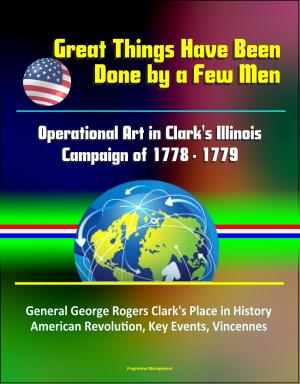Saddam's War: An Iraqi Military Perspective of the Iran-Iraq War - Saddam Hussein as Political and Military Leader, Ba'ath Party, Chemical Weapons, WMD, Iranian Strategy, Republican Guard
Nonfiction, History, Military| Author: | Progressive Management | ISBN: | 9781301662074 |
| Publisher: | Progressive Management | Publication: | January 25, 2013 |
| Imprint: | Smashwords Edition | Language: | English |
| Author: | Progressive Management |
| ISBN: | 9781301662074 |
| Publisher: | Progressive Management |
| Publication: | January 25, 2013 |
| Imprint: | Smashwords Edition |
| Language: | English |
How did the fall of Saddam Hussein's regime look from the Iraqi perspective? That question triggered the Iraqi Perspectives Project (IPP), sponsored by U.S. Joint Forces Command and the National Intelligence Council. The effort was named "Project 1946" inspired by the methodology used by U.S. Army historians and intelligence officers working with former members of the German General Staff to develop an understanding of World War II from the German perspective.
This McNair Paper covers a broad spectrum of Middle Eastern military history through the eyes of Iraqi Lieutenant General Ra'ad Hamdani, who held various command positions in the 1980-1988 war and, during Operation Iraqi Freedom, commanded the II Republican Guard Corps.
Contents: Part One * Summary and Analysis * General Comments * The Arab-Israeli Wars and the rise of the Ba'ath Party * Between the 1973 War and the Iran-Iraq War (1980-1988) * The Iran-Iraq War (1980-1988) * Thoughts on the Iran-Iraq "Cold-War" in the 1990s * Comments on * Part Two * The Interviews * Discussion One * Arab-Israeli Wars of 1967 and 1973 * Military Transition under Ba'athist Rule * Discussion Two * Iraqi Military and Political Transition through the 1970s * Prologue to Iran-Iraq War * Transition of Iranian Leadership and Military * Decision to Invade * Saddam's Aspirations * Earliest Phase of the War * Political and Professional Soldiers * Disorganized Command and Control of Iranian Operations * Discussion Three * Early Use of Air Power * SIGINT [Signals Intelligence] * Winter 1980-1981 Iraqi Command Changes * Saddam's Response to Failure and Executions * 1980-1982 Losses and Army Expansions * Developments of Iranian and Iraqi Forces * Discussion Four * Saddam's Psychology and Personality Development * January 1981 Armor Battle * Iranian Human Wave Tactics and Iraqi Minefields * Khomeini's Spiritual Influence * Battles of Abadan and Khorramshahr * Loss of Special Forces * End of Initial Iraqi Offensives in May 1981 * Discussion Five * 1981-1982 Turbulence in Tehran * Iranian Infiltration Tactics * 1982 Attacks around Basra * 1984-1988 Marsh Infiltrations and Iraqi Engineering Efforts * International Support to Iran * Chemical Weapons Usage * Iranian Response to Weapons of Mass Destruction * Postwar Preparations with WMD * 1982-1983 Reorganization and Recruiting for Republican Guard * Psychological Support of Saddam to Troops * Postwar Republican Guard Reorganization * Discussion Six * Summer 1983 Iranian Offensive into Haj Umran * Northern Mountain Operations and Kurdish Support * A 1,000-kilometer Front * Threats to the Dams and Baghdad * Unpredictable Iranian Strategy and Tactics * February 1984 Iraqi 6th Armored Division Losses * Iranian Marsh Operations * Intelligence Development and Satellite Support in March 1985 * Discussion Seven * 1986 Al-Fao Campaign and Baghdad's Misinterpretation of Iranian Strategy * Traitors in the Iraqi Leadership * Prisoners of War * Operation Dawn * Iraqi Casualty Competition and the "Bedouin Mentality" * Discussion Eight * Republican Guard Expansion and the Response to Al-Fao * Hussein Kamel * General Hamdani's Command Obstacles * 1987 Iranian Attack on Basra and Casualty Inflation * Shalamjah: The Somme of the Iran-Iraq War * Hamdani's Venture through the Front and the Battlefield Conditions * Discussion Nine * July 1987 Republican Guard Command Changes * Battlefield Missiles * Halabjah * Factors of Post-1987 Shift in "Correlation of Forces" toward Iraq-Planning Effort for Al-Fao Offensive * Use of Helicopters * Front of 1988 * July 1988 Iraqi Incursion through to Ahvaz and the Mujahideen-e-Khalq * Discussion Ten * Foundations of the Iraqi Military and Saddam's Detrimental Influence * Hamdani's Effort to Improve Iraqi Military Culture * Questioning Military Orders and Planning * Lessons Learned from the Iran-Iraq War
How did the fall of Saddam Hussein's regime look from the Iraqi perspective? That question triggered the Iraqi Perspectives Project (IPP), sponsored by U.S. Joint Forces Command and the National Intelligence Council. The effort was named "Project 1946" inspired by the methodology used by U.S. Army historians and intelligence officers working with former members of the German General Staff to develop an understanding of World War II from the German perspective.
This McNair Paper covers a broad spectrum of Middle Eastern military history through the eyes of Iraqi Lieutenant General Ra'ad Hamdani, who held various command positions in the 1980-1988 war and, during Operation Iraqi Freedom, commanded the II Republican Guard Corps.
Contents: Part One * Summary and Analysis * General Comments * The Arab-Israeli Wars and the rise of the Ba'ath Party * Between the 1973 War and the Iran-Iraq War (1980-1988) * The Iran-Iraq War (1980-1988) * Thoughts on the Iran-Iraq "Cold-War" in the 1990s * Comments on * Part Two * The Interviews * Discussion One * Arab-Israeli Wars of 1967 and 1973 * Military Transition under Ba'athist Rule * Discussion Two * Iraqi Military and Political Transition through the 1970s * Prologue to Iran-Iraq War * Transition of Iranian Leadership and Military * Decision to Invade * Saddam's Aspirations * Earliest Phase of the War * Political and Professional Soldiers * Disorganized Command and Control of Iranian Operations * Discussion Three * Early Use of Air Power * SIGINT [Signals Intelligence] * Winter 1980-1981 Iraqi Command Changes * Saddam's Response to Failure and Executions * 1980-1982 Losses and Army Expansions * Developments of Iranian and Iraqi Forces * Discussion Four * Saddam's Psychology and Personality Development * January 1981 Armor Battle * Iranian Human Wave Tactics and Iraqi Minefields * Khomeini's Spiritual Influence * Battles of Abadan and Khorramshahr * Loss of Special Forces * End of Initial Iraqi Offensives in May 1981 * Discussion Five * 1981-1982 Turbulence in Tehran * Iranian Infiltration Tactics * 1982 Attacks around Basra * 1984-1988 Marsh Infiltrations and Iraqi Engineering Efforts * International Support to Iran * Chemical Weapons Usage * Iranian Response to Weapons of Mass Destruction * Postwar Preparations with WMD * 1982-1983 Reorganization and Recruiting for Republican Guard * Psychological Support of Saddam to Troops * Postwar Republican Guard Reorganization * Discussion Six * Summer 1983 Iranian Offensive into Haj Umran * Northern Mountain Operations and Kurdish Support * A 1,000-kilometer Front * Threats to the Dams and Baghdad * Unpredictable Iranian Strategy and Tactics * February 1984 Iraqi 6th Armored Division Losses * Iranian Marsh Operations * Intelligence Development and Satellite Support in March 1985 * Discussion Seven * 1986 Al-Fao Campaign and Baghdad's Misinterpretation of Iranian Strategy * Traitors in the Iraqi Leadership * Prisoners of War * Operation Dawn * Iraqi Casualty Competition and the "Bedouin Mentality" * Discussion Eight * Republican Guard Expansion and the Response to Al-Fao * Hussein Kamel * General Hamdani's Command Obstacles * 1987 Iranian Attack on Basra and Casualty Inflation * Shalamjah: The Somme of the Iran-Iraq War * Hamdani's Venture through the Front and the Battlefield Conditions * Discussion Nine * July 1987 Republican Guard Command Changes * Battlefield Missiles * Halabjah * Factors of Post-1987 Shift in "Correlation of Forces" toward Iraq-Planning Effort for Al-Fao Offensive * Use of Helicopters * Front of 1988 * July 1988 Iraqi Incursion through to Ahvaz and the Mujahideen-e-Khalq * Discussion Ten * Foundations of the Iraqi Military and Saddam's Detrimental Influence * Hamdani's Effort to Improve Iraqi Military Culture * Questioning Military Orders and Planning * Lessons Learned from the Iran-Iraq War















